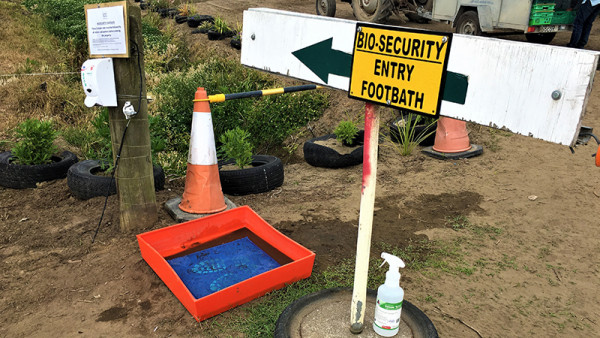On-farm biosecurity series: People
3 May 2023
Words by Anna Rathé, HortNZ biosecurity manager.
First published in the November 2021 issues of the magazines.

People come and go regularly from horticultural farms and orchards and have likely visited a range of different places before arriving at your operation.
Precautionary actions can be taken to minimise any biosecurity risk associated with people coming onto your property. The movement of people and the actions required of them should be included in your on-farm biosecurity plan.
Contact your industry body to see if they have a crop-specific template that you can use. If not, you can use the Horticulture New Zealand template that is available online. Some of the common risk areas associated with people are explored below, along with risk reduction actions for you to consider.
Staff and visitors
Consider who visits your property – likely a wide range of people such as staff, suppliers, advisors, crop scouts, contractors, transport providers, guests and possibly also people living on the property. Anyone coming onto your property can inadvertently carry pests, pathogens or weed seeds with them on their clothing, footwear, vehicles or even skin.
Consider the risk posed by each visitor before you decide whether to let them onto your site or not – ask them what type of properties they have recently been on and whether they can provide assurance that their clothing, hands, shoes, vehicles and equipment are clean. Provide cleaning facilities, including footbaths containing an appropriate sanitising product to prevent the spread of pathogens that may be on footwear. You may also wish to provide clean clothing and footwear for visitor use on site.
It’s useful to limit access and parking to a single point on your property so people’s movements are contained to one part of the site. Limit visitor access to crops and production areas unless essential. Be sure to keep a visitor log so that you have a record of who has been on the property. This is invaluable if a biosecurity event occurs and forwards or backwards tracing is required.
Communicating your requirements and expectations
Make sure your biosecurity expectations are clear to all visitors and staff.
Don’t assume that they already know good biosecurity practices. Use clear signage to convey key instructions. As contractors, advisors and crop scouts often move straight from farm to farm or orchard to orchard, there is a higher risk that they will transfer pests, pathogens and weeds if biosecurity risk management practices are not followed. Take extra care to discuss your expectations with these types of visitors, focusing on the following points:
- The biosecurity practises you want them to implement.
- How you can check that they are undertaking these practises.
- Contractors who follow good biosecurity practises generally take more time – what level of risk are you prepared to accept?
- Whether biosecurity requirements can be included in contractual arrangements.
Training
Staff are likely to spend a lot of time on site, and providing training ensures they have a good level of biosecurity awareness and understand what is required of them. Training could include:
- Expected day-to-day biosecurity practises. You can put posters up in common areas to keep good biosecurity practises front of mind for staff.
- Knowing what to look for (what is normal and what is unusual). Many product groups provide information on the highest risk exotic pests for the crop, information which is useful to have on display.
- How to keep good records of your farm inputs and outputs to allow trace-back and trace-forward if a biosecurity event occurs.
Reporting
Early detection of any new exotic organisms is essential if we are to maximise the chances of successful eradication. Encourage a culture of reporting suspect pest, pathogen or weed detections via the Ministry for Primary Industries pest and disease hotline 0800 80 99 66 and ensure all staff are familiar with the signs and symptoms of pests and diseases of concern.
In conclusion
The above is not an exhaustive list. You should identify any additional people movements and actions that take place on your property and think about how to minimise any potential biosecurity risk that they may pose.
Disclaimer: While every effort has been made to ensure the information in this publication is accurate, Horticulture New Zealand does not accept any responsibility or liability for error of fact, omission, interpretation or opinion that may be present, nor for the consequences of any decisions based on this information.
